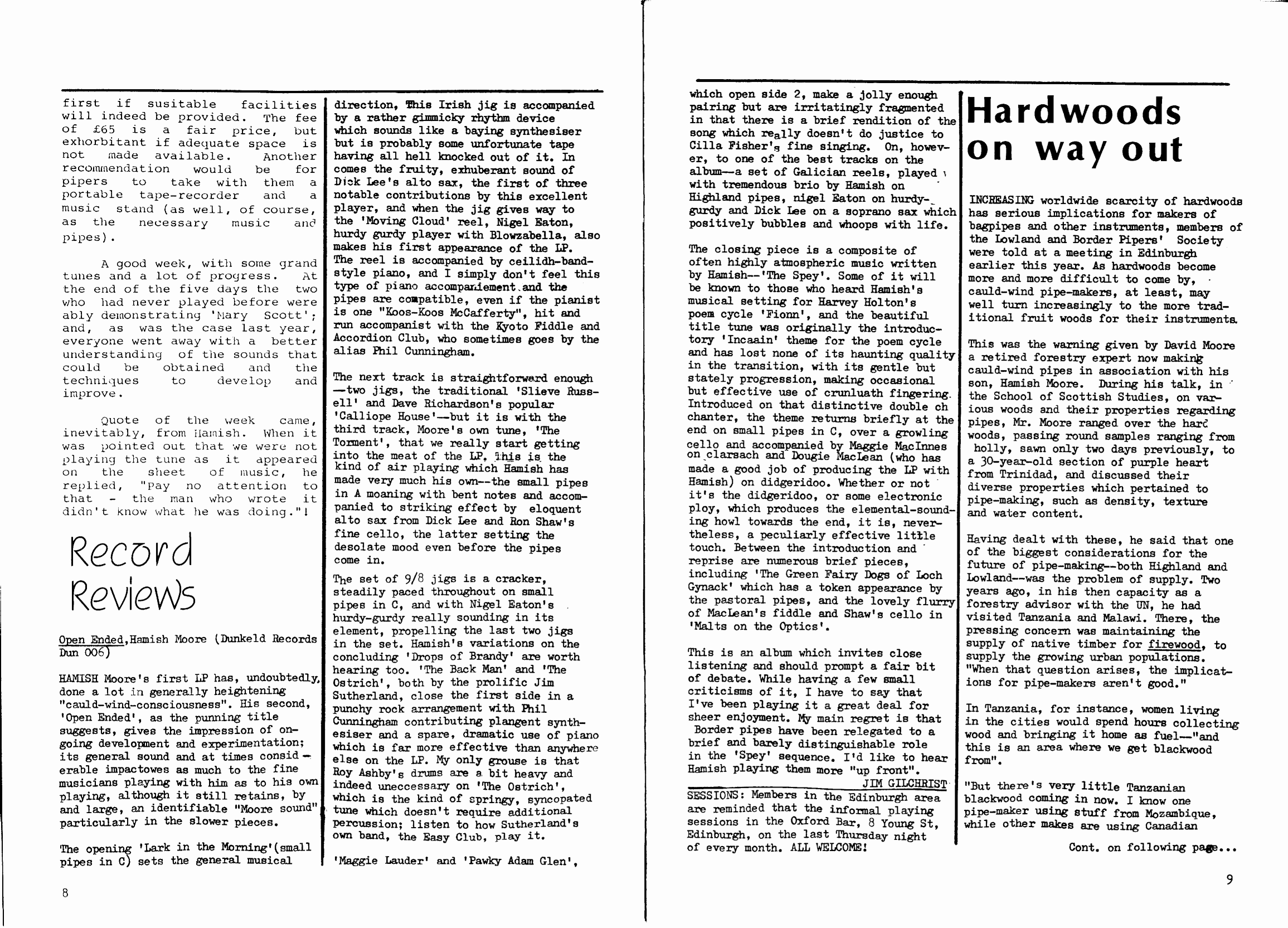Record Reviews

Open Ended, Hamish Moore (Dunkeld Records Dun 006)
HAMISH Moore's first LP has, undoubtedly, done a lot in generally heightening "cauld-wind-consciousness". His second, ‘Open Ended', as the punning title suggests, gives the impression of ongoing development and experimentation; it’s general sound and at times considerable impact owes as much to the fine musicians playing with him as to his own playing, although it still retains, by and large, an identifiable "Moore sound" particularly in the slower pieces.
The opening ‘Lark in the Morning' (small pipes in C) sets the general musical direction, This Irish jig is accompanied by a rather gimmicky rhythm evice which sounds like a baying synthesiser but is probably some unfortunate tape having all hell knocked out of it. In comes the fruity, exuberant sound of Dick Lee's alto sax, the first of three notable contributions by this excellent player, and when the jig gives way to the 'Moving Cloud' reel, Nigel Eaton, hurdy gurdy player with Blowzabella, makes his first appearance of the LP. , also The reel is accompanied by ceilidh-band style piano, and I simply don't feel this type of piano accompaniment and the pipes are compatible, even if the pianist is one "Koos-Koos McCafferty", hit and run accompanist with the Kyoto Fiddle and Accordion Club, who sometimes goes by the alias Phil
Cunningham.
The next track is straightforward enough —two jigs, the traditional 'Slieve Russell’ and Dave Richardson's popular "Calliope House' - but it is with the third track, Moore's own tune, 'The Torment', that we really start getting into the meat of the LP, this is the kind of air playing which Hamish has made very much his own--the small pipes in A moaning with bent notes and accompanied to striking effect by eloquent alto sax from Dick Lee and Ron Shaw's fine cello, the latter setting the desolate mood even before the pipes come in.
The set of 9/8 jigs is a cracker, steadily paced throughout on small pipes in C, and with Nigel Eaton's hurdy-gurdy really sounding in its element, propelling the last two jigs in the set. Hamish's variations on the concluding ‘Drops of Brandy' are worth hearing too. 'The Back Man' and 'The Ostrich', both by the prolific Jim Sutherland, close the first side in a punchy rock arrangement with Phil Cunningham contributing plangent synthesiser and a spare, dramatic use of piano which is far more effective than anywhere else on the LP. My only grouse is that Roy Ashby's drums are a bit heavy and indeed unnecessary on 'The Ostrich’, which is the kind of springy, syncopated tune which doesn't require additional percussion; listen to how Sutherland's own band, the Easy Club, play it.
‘Maggie Lauder’ and ‘Pawky Adam Glen, Which open side 2, make a jolly enough pairing but are irritatingly fragmented in that there is a brief rendition of the song which really doesn't do justice to Cilla Fisher's fine singing.
On, however, to one of the best tracks on the album— a set of Galician reels, played with tremendous brio by Hamish on Highland pipes, Nigel Eaton on hurdy-gurdy and Dick Lee on a soprano sax which positively bubbles and whoops with life.
The closing piece is a composite of often highly atmospheric music written by Hamish--'The Spey’. Some of it will be known to those who heard Hamish's musical setting for Harvey Holton's poem cycle 'Fionn', and the beautiful title tune was originally the introductory 'Incaain' theme for the poem cycle and has lost none of its haunting quality in the transition, with its gentle but stately progression, making occasional but effective use of crunluath fingering. Introduced on that distinctive double chanter, the theme returns briefly at the end on small pipes in C, over a growling cello and accompanied by Maggie MacInnes on clarsach and Dougie lean (who has made a good job of producing the LP with Hamish) on didgeridoo. Whether or not ~ it's the didgeridoo, or some electronic ploy, which produces the elemental-sounding howl towards the end, it is, nevertheless, a peculiarly effective little touch. Between the introduction and reprise are numerous brief pieces, including 'The Green Fairy Dogs of Loch Gynack' which has a token appearance by the pastoral pipes, and and the lovely flurry of Maclean's fiddle and Shaw's cello in 'Malts on the Optics'.
This is an album which invites close listening and should prompt a fair bit of debate. While having a few small criticisms of it, I have to say that I've been playing it a great deal for sheer enjoyment. My main regret is that Border pipes have been relegated to a brief and barely distinguishable role in the 'Spey' sequence, I'd like to hear Hamish playing them more “up front".
JIM GILCHRIST.
